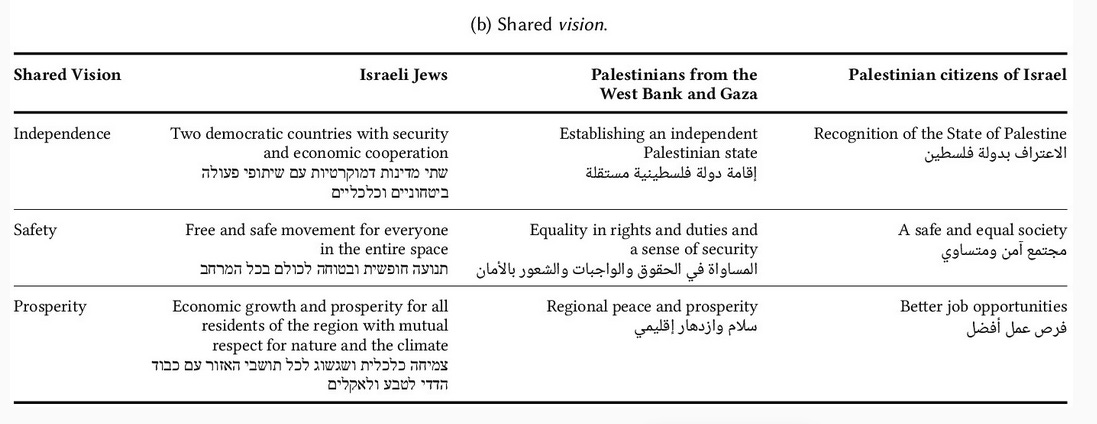Algorithmically-enhanced consensus seeking
A hard test of whether we can use technology to enhance dialogue across conflict lines
In a break from recent posts on understanding generative AI, I review a recent paper: Using collective dialogues and AI to find common ground between Israeli and Palestinian peacebuilders (Konya et al, 2025).
A new paper shows how AI can be used to support consensus, even in the toughest of conflicts.
Following the Hamas attacks of October 7th 2023 many held that finding common ground between Israeli and Palestinians was unlikely and even the possibility of constructive dialogue was viewed with skepticism.
A group of researchers partnered with the Alliance for Middle East Peace to run consensus seeking dialogues involving Israeli Jews, Palestinian citizens of Israel and Palestinians from the West Bank and Gaza. The overall aim was to agree on values and the visions for the future of the region, along with red lines which define the scope of future dialogue for both sides.
To approach this hardest of hard tasks, they designed a process with human discussion at the core, but supported by computer language models and calculation methods which identified positions with maximum agreement across the different groups.
Technologically enhanced dialogues
Here’s how technology was used at each stage.
First, participants met online in predetermined uni-national groups: Israeli Jews, Palestinian citizens of Israel, and Palestinians from the West Bank and Gaza. Online discussions have their limitations, but they bring convenience, the possibility for anonymity (which may be particularly beneficial for discussions of sensitive issues), and they make it easy to collect participant behaviours - from their votes to their contributions in text. After meeting in uni-national groups there was a final stage involving all groups. Here the advantage of online shows - allowing geographically dispersed participants to meet, even across active conflict zones.
Second, language models were used for translation: in the final stage the evolving consensus statements were presented simultaneously in Hebrew, Palestinian Arabic and English. Here’s a quote from the paper:
"Peacebuilders’ native languages span Hebrew, Palestinian Arabic, and English. Beyond communication, language carries deep cultural and historical significance, where it has been a tool of identity and a subtext of power imbalance. It was crucial for inclusivity and legitimacy that participants could engage fully in their native languages. Additionally, the sensitivity of language in this context extends to word choices that may reflect deeply rooted political and cultural meanings."
Third, language models were used to identify statements which were similar to each other and to produce a single clear formulation which could capture what was meant. This seems like an excellent use of what LLMs are good at - finding alignment between sentences which use different words but have similar meanings, summarising and rephrasing.
Fourth, participants’ attitudes to the consensus statements were aggregated using bridging based algorithms. These are the family of methods used by platforms like pol.is or moderation systems like Community Notes. Bridging based algorithms identify items which win “diverse approval” - not the most numerically popular items, but those which are endorsed by participants who hold a spectrum of views on other items. The contrast with traditional social media recommendation algorithms, which promote items based on their ability to provoke engagement (i.e. inflame or upset people), is marked.
Fifth, humans in the loop. Fine, strictly, this isn’t technology in the silicon-and-bytes sense, but it is fundamental to the approach adopted by Konya et al, 2025. As well as partnering with the Alliance for Middle East Peace network to recruit peacebuilding professionals to the dialogue, they worked with language and domain experts to provide moderation and checking of automated translation choices. The statements which were selected by the algorithm to have the most diverse endorsement were voted on collectively in a final stage. Voting is a transparent and commonly understood mechnanism which the authors present as vital in validating output of what was a complicated overall process.
Did it work?
The report makes clear that this is not an experiment - there is no comparison made here between alternative methods.
They are able to report some success - positive feedback from participants and the partner organisation (“Without this process, our conversations would be smaller and fragmented. This method brought voices together across political and geographic divides in a way that traditional dialogue simply couldn’t.”), as well as the creation of the consensus statements themselves, each of which has “at least 84% agreement” from participants.
Perhaps the single greatest achievement of the work may be just to show that it is possible. Quoting the report:
While prior work has shown the effectiveness of integrating similar techniques in low-stakes settings, this work is an “existence proof” that (i) these technologies can be used within high-stakes conflict settings while maintaining trust; (ii) that a scalable method can successfully bridge divides among distrustful groups amid active conflict; and (iii) that such processes can be made equitable despite significant structural asymmetries between participants.
The output
The dialogue process worked on different sets of statements: red lines (which define acceptable positions beyond which the participants believed both they and the “other side”) could not cross for dialogue to continue; shared values, and visions for the future of the region. You can see all these in the original paper. Here is the shared vision:

And it is worth repeating this from the report:
"while some of the identified areas of common ground may appear self-evident in retrospect, at that time this project us undertaken, a prevailing sentiment held that finding common ground was unlikely, and the prospect of a constructive joint dialogue was viewed with considerable skepticism."
Further
Around 138 people participated in the joint phase. Five collective statements comprising joint demands to world leaders were produced…. Each statement had at least 90% agreement among participants from each side… and one demand was universally ranked first: “An immediate ceasefire and release of all hostages.” These demands were then composed into a “joint letter” for inclusion in briefs and advocacy efforts :
The joint letter:
“We write as a united body of Israeli and Palestinian peacebuilders, compelled by the urgency of our shared pain and galvanized with the hope we still hold for the future. We call for the following:
• An immediate ceasefire and release of all hostages
• The creation of an international fund to build the foundations for a comprehensive long-term solution
• The establishment of a globalized coalition to assist Gaza’s reconstruction
• The inclusion of civil society and NGOs in all peacebuilding and diplomatic discussions
• The recognition of both sides’ trauma
Acknowledging the trauma and pain experienced by both sides is essential for the healing of our societies and the achievement of sustainable peace. Help us break the cycle of violence so the next generation may flourish. The world watches, and history will judge. Now is the time to act.”
Conclusion
While the work has limitations - perhaps primarily the limited number and nature of participants recruited - I find it exciting to see AI researchers trying to use their powers for good, in one of the hardest circumstances imaginable for constructive dialogue. The embedded approach to a real-word problem, trying to create dialogue out of conflict is a great contrast to the normally detached work of algorithmic-sorcerers who concoct new ways to make people click on ads and create conflict from dialogue. It gives me hope that technology can be part of the solution as well as contributing to the new flavour of the problems we have.
Citation:
Konya, A., Thorburn, L., Almasri, W., Leshem, O. A., Procaccia, A., Schirch, L., & Bakker, M. (2025, June). Using collective dialogues and AI to find common ground between Israeli and Palestinian peacebuilders. In Proceedings of the 2025 ACM Conference on Fairness, Accountability, and Transparency (pp. 312-333). https://doi.org/10.1145/3715275.3732022
Abstract:
A growing body of work has shown that AI-assisted methods — leveraging large language models, social choice methods, and collective dialogues — can help navigate polarization and surface common ground in controlled lab settings. But what can these approaches contribute in real-world contexts? We present a case study applying these techniques to find common ground between Israeli and Palestinian peacebuilders in the period following October 7th, 2023. From April to July 2024 an iterative deliberative process combining LLMs, bridging-based ranking, and collective dialogues was conducted in partnership with the Alliance for Middle East Peace. Around 138 civil society peacebuilders participated including Israeli Jews, Palestinian citizens of Israel, and Palestinians from the West Bank and Gaza. The process resulted in a set of collective statements, including demands to world leaders, with at least 84% agreement from participants on each side. In this paper, we document the process, results, challenges, and important open questions.
Other stuff…
Conspirador Norteño: A brief look at recent X Community Notes regarding the Jeffrey Epstein/Ghislaine Maxwell case
In the two month period ranging from June 18th to August 18th, 2025, a total of 672 Community Notes containing “Epstein”, “Ghislaine”, or “Maxwell” were written. As of August 20th, 2025, 73 of these notes (10.8%) were rated helpful and shown on the relevant posts; the vast majority of the remaining 599 did not accumulate enough ratings from users with different perspectives to be ruled either helpful or unhelpful.
Previously
My serious on thought-handles for grabbling with generative AI will continue soon. Catch up :
… And finally
A photo of a tree in Jayyous village, a Palestinian village in the West Bank which is next to the border with Israel.
Source: This facebook page, a twinning project between a Norwegian village and Jayyous
END
Comments? Feedback? Visions for the future? I am tom@idiolect.org.uk and on Mastodon at @tomstafford@mastodon.online



see also
https://www.researchgate.net/publication/394937380_How_Can_AI_Help_Achieve_Effective_Deliberation_at_Scale